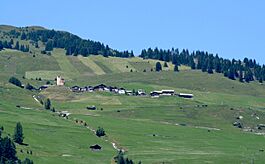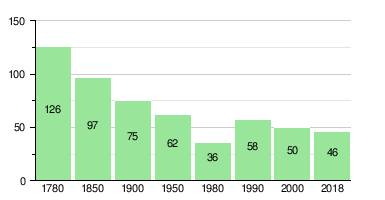Lohn, Graubünden facts for kids
Quick facts for kids
Lohn
|
||
|---|---|---|
 |
||
|
||
| Country | Switzerland | |
| Canton | Graubünden | |
| District | Viamala | |
| Area | ||
| • Total | 43.95 km2 (16.97 sq mi) | |
| Elevation | 1,585 m (5,200 ft) | |
| Population
(December 2019)
|
||
| • Total | 52 | |
| • Density | 1.183/km2 (3.064/sq mi) | |
| Postal code |
7433
|
|
| Surrounded by | Donat, Mathon, Rongellen, Thusis, Tschappina, Urmein, Zillis-Reischen | |
Lohn (which is Lon in Romansh) used to be a municipality in the Viamala Region in the Swiss canton of Graubünden. On January 1, 2021, Lohn joined with the former municipalities of Casti-Wergenstein, Donat, and Mathon to create a new municipality called Muntogna da Schons.
History of Lohn
Lohn was first mentioned in old writings around the middle of the 1100s. Back then, it was known by names like Laune and Lune. Later, in 1219, it was called de Laone.
Geography of Lohn
In 2006, Lohn covered an area of about 8.1 square kilometers (which is about 3.1 square miles).
- More than half of this land (56.5%) was used for farming.
- About 35% was covered by forests.
- A small part (1.5%) had buildings or roads.
- The rest (7%) was made up of things like rivers, glaciers, or mountains that aren't used for farming or building.
Before 2017, Lohn was part of the Schams sub-district. After 2017, it became part of the Viamala Region. Lohn is a type of village called a haufendorf. This means it's an unplanned village with buildings packed closely together around a central area. It is located high up on the Schamserberg mountain, at an elevation of about 1,582 meters (5,190 feet).
People and Population
In 2019, Lohn had a population of 52 people. Over the past 10 years, the number of people living there has gone down by about 10.7%.
In 2000, the population was made up of 44% males and 56% females.
- About 10% of the people were between 0 and 9 years old.
- Another 18% were between 10 and 14 years old.
- Most adults were in their 30s, 40s, 60s, and 70s.
In the 2007 national election, where people vote for their government representatives, the most popular political party in Lohn was the SVP. They received 45.1% of the votes. Other popular parties included the FDP and the SPS.
Many adults in Lohn (about 82.4% of those aged 25-64) have finished either high school or gone on to higher education, like university.
Lohn has a very low unemployment rate, meaning almost everyone who wants a job has one. In 2005, 23 people worked in the primary economic sector, which mainly involves farming and other activities that get raw materials from nature. There were about 7 businesses in this sector.
The graph below shows how the population of Lohn has changed over time:

Languages Spoken
In 2000, most people in Lohn (52%) spoke Rhaeto-Romance, which is a language spoken in parts of Switzerland. The rest (48%) spoke German.
The table below shows how the number of people speaking German and Romanish has changed over the years:
| Languages | Census 1980 | Census 1990 | Census 2000 | |||
|---|---|---|---|---|---|---|
| Number | Percent | Number | Percent | Number | Percent | |
| German | 0 | 0.00% | 18 | 37.50% | 24 | 48.00% |
| Romanish | 36 | 100% | 30 | 62.50% | 26 | 52.00% |
| Population | 36 | 100% | 48 | 100% | 50 | 100% |
See also
 In Spanish: Lohn (Grisones) para niños
In Spanish: Lohn (Grisones) para niños




